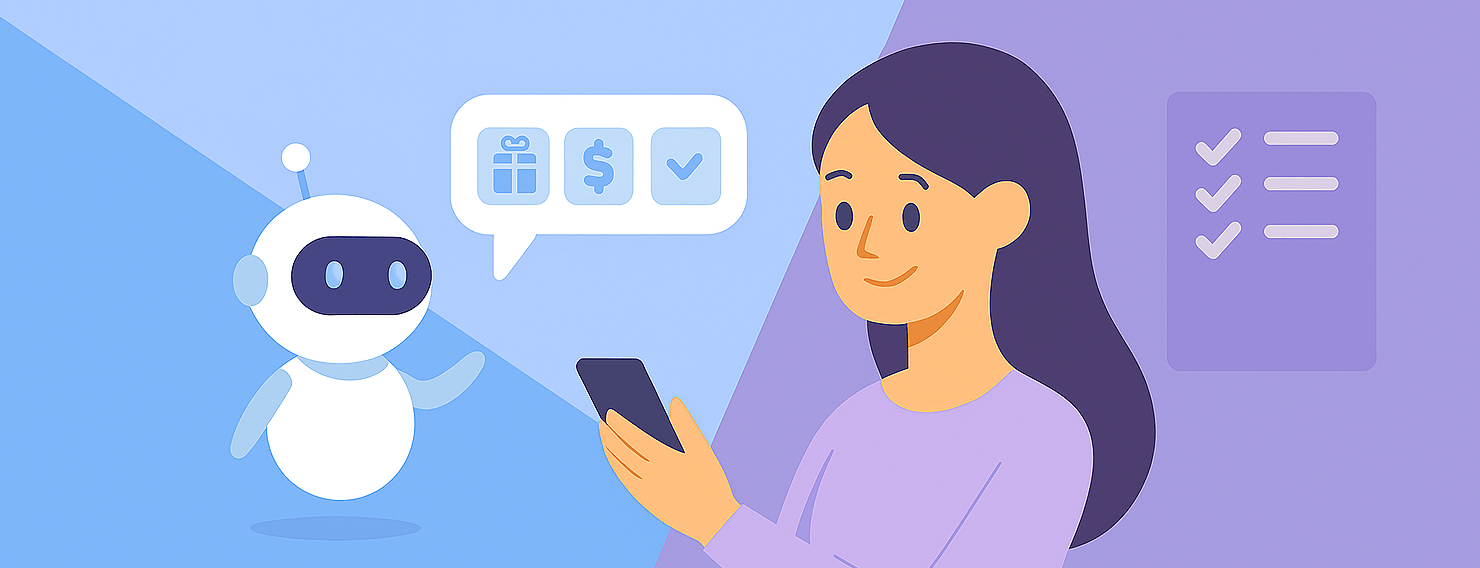Table of Contents
- Key Takeaways
- High‑Ticket vs. High‑Consideration (Not the Same Thing)
- The Psychology of High‑Ticket Hesitation
- Market Momentum & Hard Numbers
- The Behavior Shift: Shoppers Will Ask If the Bot Actually Helps
- Why Chatbots Fit High‑Ticket Sales So Well
- Why Chatbots Don’t Click for Low‑Ticket Items
- Anatomy of a “Concierge AI”
- Real Brands, Real Numbers
- Implementation Roadmap
- KPI Dashboard for High‑Value SKUs
- Risks & How to Defuse Them
- Chatbots Don’t Replace Sales, They Scale It
Are chatbots those clunky pop-ups that get in the way? Not anymore, at least not where the purchase really matters. Take Kendra Scott. The brand’s AI Copilot now helps answer roughly 93% of shopper questions, influences about 6% of sales, and has driven a 160% jump in revenue tied to bot-assisted interactions compared to the older version they were using back in 2024. That’s not just customer support, that’s assisted selling at scale.
And it’s not just jewelry. Adobe’s commerce data shows AI-assisted traffic is closing the conversion gap fastest in research‑heavy categories like electronics. The more specs, configuration steps, or emotional stakes in the purchase, the more a good chatbot can help move people forward. Think jewelry, premium electronics, auto research, configurable furniture, and even luxury gifting.
So what’s going on? Why are results like this showing up most strongly in higher‑consideration buys, the stuff where fit, specs, taste, occasion, or risk make people pause before clicking “Buy”?
Bottom line: Conversational AI doesn’t magically make low-interest items exciting. It shines when the decision is the hard part. Let’s dig into why.
Key Takeaways
- Chatbots drive the most value in categories where shoppers fear getting it wrong (fit, spec, gifting, warranty), even when the item isn’t ultra‑expensive. Reduce friction and confidence goes up.
- Structured attributes (materials, dimensions, compatibility, finish) and short guided questions (“Gift?” “Budget?” “Metal?”) turn a chatbot into a digital sales associate instead of an FAQ trap.
- Always show a human fallback, acknowledge emotion (especially in gifts/luxury), and be transparent. That’s the difference between engagement and abandonment.
- Track % resolved, guided flow completion, escalation satisfaction, influenced revenue, and return reduction on bot‑touched orders. These show business impact far better than raw chat volume.
- Start with assist and escalation, then add guided discovery, configurators, personalization, and proactive alerts. Site speed and clean data multiply every lift.
High‑Ticket vs. High‑Consideration (Not the Same Thing)
Price matters, but it’s not the whole story. When teams talk “high‑ticket,” they usually mean price bands – say under $250 (impulse/light research), $250-$1K (getting into comparison mode), and $1K+ (budget check, review reading, maybe financing). Your numbers will vary by category, but using price bands like these helps you segment buyer journeys and decide where assisted selling (chatbot, live consult, configurator) delivers the most lift.
High‑consideration is different. It kicks in when shoppers can’t afford to be wrong, even if the item isn’t wildly expensive. Think: Will this pendant match the metal she actually wears? Will this laptop support video editing? Will that sectional fit through the stairwell? Complexity triggers – fit, specs, customization rules, warranty risk, gifting anxiety – explain why Adobe’s data shows AI‑assisted traffic converting best in research‑heavy categories like electronics and jewelry, while lifts are muted in low‑stakes, habitual buys such as apparel or grocery.
Layered on top of complexity is emotion. A mid‑priced piece of jewelry bought for a milestone birthday carries way more decision pressure than grabbing a discounted TV mount. Shoppers lean on AI to parse specs and context (“best 65‑inch TV for bright room under $1K”) or to narrow gift options when they’re unsure what will land well. Exactly the kind of friction bots can reduce.
Finally, customization multiplies friction. In furniture, kitchens, or any build‑to‑order product, buyers struggle to visualize combinations, dimensions, and finishes. Guided configurators paired with chatbots let shoppers experiment in real time and get clarifying answers on the fly, shrinking uncertainty and accelerating confident decisions.
Put simply: More friction = more room for a good bot to help.
That rising friction doesn’t just lengthen the decision journey; it also cranks up the psychological heat behind every click. When the stakes feel high (because the price tag is steep, the specs are dense, or the gift simply has to be perfect), shoppers slide from rational comparison into emotional hesitation. To understand why a chatbot can rescue the sale, we first need to unpack what’s going on inside the buyer’s mind.
The Psychology of High‑Ticket Hesitation
You’ve definitely hovered over the “Buy Now” button on something pricey, then frozen? That’s the confidence gap in action. Here’s what’s happening in our heads:
“What if I mess this up?”
Big‑ticket items come with big‑ticket worries. A €40 phone case you can return in a snap; a €4 000 laptop, not so much. The higher the price, the louder the little voice saying, “Don’t blow your money on the wrong thing.”
“Can someone just show me the best options?”
When we shop for something complicated – say, a diamond ring – we don’t actually want 500 choices. We want a friendly guide who replies, “Here are the three sparkliest cuts under €2 000, and here’s why they’re worth it.” Guided discovery shrinks the search and soothes the stress.
“Talk to me like a human, please.”
Before we hand over serious cash, we need instant reassurance from someone (or something) that seems to get us. Modern AI chat can now crack a joke, empathize with our indecision, and confirm that yes, the sofa will fit through our front door, all in real time. That warm, human‑style back‑and‑forth is the nudge that turns “Maybe later” into “Add to cart.”
Market Momentum & Hard Numbers
AI chat isn’t a “nice‑to‑have” add‑on anymore. It’s swiftly becoming the main stage of online service, especially when there’s serious money in the cart. Check the scoreboard:
- A recent survey shows 57 % of retail leaders expect chat‑based customer support to be the single biggest area reshaped by AI. In other words, more than half the industry is betting the help button will soon be AI‑first
- The global chatbot market ballooned to US $1.42 billion in 2025, racking up a healthy 19 % compound annual growth rate. Investors only pour cash into tech that’s actually gaining traction, so the runway clearly looks long.
- Brands that rolled out AI “personal shoppers” are already seeing 25-40 % jumps in conversions and up to 50% fewer abandoned carts. Huge wins when each sale tops four figures.
Put simply: shoppers are voting with their wallets, boards are approving bigger budgets, and AI chat is moving from experiment to essential, especially when the price tag makes every conversation count.
But market traction alone doesn’t close deals. As AI chat turns from novelty into the default help desk, shoppers are raising their expectations just as quickly. Understanding how those expectations are shifting is the next piece of the puzzle.
The Behavior Shift: Shoppers Will Ask If the Bot Actually Helps
Picture this: you’re three clicks into a pricey purchase, you have a burning question, and the site’s chatbot pops up. Will you use it? Most shoppers say “yes” but only under the right conditions.
- Speed first. An EMARKETER study found that 71% of shoppers worldwide want an AI agent that answers questions faster than a human queue.
- Hands on the wheel, please. Enthusiasm nosedives when bots take the wheel: just 47% are cool with an AI agent actually buying recommended products on their behalf. In high-ticket journeys, “assist, don’t auto-buy” is the golden rule.
- Privacy brakes are still on. The trust gap is real: only 24% of U.S. consumers feel comfortable sharing data with an AI shopping tool. Transparency about what the bot knows and how it uses it remains table stakes.
Shoppers love a smart sidekick that answers quickly and helps them choose. They bolt when that sidekick goes rogue or gets nosy. High-ticket brands should design chatbots as helpful advisors, not autopilots, and make data use crystal-clear from the first “How can I help?”
Why Chatbots Fit High‑Ticket Sales So Well
Here’s the secret sauce behind those surprisingly smooth, big‑ticket checkouts.
First, they turn option overload into a guided tour. Think about configuring a new SUV or designing a bespoke engagement ring – hundreds of choices, endless second‑guessing. A smart chatbot breaks that maze into bite‑sized prompts: “Leather or vegan?” “Platinum or rose gold?”. AI‑driven chatbots can tap structured feeds (specs, inventory, financing terms, warranty rules) and resolve more than 80 % of customer questions on their own. You make one decision at a time, watch the picture update in real‑time, and never feel lost. Cognitive load drops, confidence rises.
Second, they answer the money questions instantly. High-priced items often hinge on payment plans or real‑time availability. With built‑in finance calculators and live inventory checks, a bot can say, “Yes, that sapphire is in stock, and here’s what your 12‑month payment would look like interest‑free.” No emailing a sales rep. No waiting for a call back. Momentum stays high.
Baymard’s 2025 research shows that roughly 70 % of online carts are abandoned, largely because last‑minute doubts – shipping cost, return policy, “Will this fit?”- go unresolved. For expensive items, those doubts are magnified. A well‑trained bot can surface the precise reassurance (e.g., “Yes, our 30‑day no‑questions return covers custom configurations”) right when the buyer hovers at the edge of commitment.
Third, they serve the global night‑owl. Affluent shoppers live in every time zone, and impulse strikes at odd hours. Your human team clocks out; your AI concierge never does. Whether it’s midnight in Melbourne or dawn in Dubai, the bot is ready to pull up swatches, schedule white‑glove delivery, or find a local showroom for tomorrow.
Finally, they remember everything and use it wisely. Every question you ask the bot becomes a clue: your ring size, preferred finishes, and budget ceiling. Those signals flow into the brand’s CRM, powering perfectly timed follow‑ups, matching earrings next month, and complimentary cleanings a year later. The result? Higher customer lifetime value without feeling stalked.
Put it all together and you’ve got an always‑on, hyper‑helpful guide that removes friction, builds trust, and nudges that pricey “maybe” into a confident “add to cart.”
Why Chatbots Don’t Click for Low‑Ticket Items
When the basket is a €12 graphic tee or a carton of oat milk, shoppers value velocity over conversation. One‑third of consumers cite “a frustrating checkout process” as the #1 reason they switch retailers for everyday buys, and 18% abandon carts outright when the flow feels too long or fiddly. In fast‑fashion and grocery, every extra tap or prompt is perceived as a detour, so the mere act of launching a chatbot can feel like road work on a one‑lane street.
For small purchases, convenience trumps curation. Half of U.S. shoppers say the ease of a merchant’s checkout determines where they buy next, with guest‑ or one‑click options lifting conversion by up to 45 %. A chatbot that asks “How can I help?” before the credit‑card field effectively adds steps, undermining the friction‑free promise that keeps low‑AOV customers loyal.
Consumers also question the point: “Why chat about a €15 T‑shirt?” Their skepticism shows in the data. 43% of U.S. adults say AI chatbots are rarely or never helpful for purchase questions, a sentiment that spikes in low‑consideration categories where specs and financing aren’t part of the decision.
Chatbots thrive when the cost of confusion is high; they stumble when the cost of waiting is higher. For milk, mascara, and mass‑market tees, efficiency beats eloquence every time, so brands should reserve conversational AI for moments where guidance, not just speed, drives the sale.
Anatomy of a “Concierge AI”
So what does a top‑tier, high‑ticket chatbot look like under the hood? Picture four layers that work together like a luxury sales team, only faster and always on.
1. Front end: the friendly face
Everything starts with a chat window that feels as natural as talking to a store associate. Shoppers can type, tap an emoji, snap a photo of a dream sofa, or even speak aloud if they prefer voice. This multimodal input lets them explain exactly what they want – no awkward menus, no clunky forms – mirroring the easy back‑and‑forth of an in‑store conversation.
2. Guidance engine
Behind that chat sits a brainy layer that runs style quizzes, budget sliders, and quick comparison tables. Instead of dumping 200 products on you, it narrows the field to two or three perfect fits. “Concierge AI” is basically the friend who knows your taste and budget and says, “Trust me, these are the ones.”
3. Trust builders
Expensive buys trigger second thoughts, so the bot bakes in instant reassurances:
- Human hand‑off buttons if you want a specialist now.
- Provenance certificates or ingredient lists that pop up on request.
- Real‑time pricing APIs so you know the quote is fresh and legit.
Together, they strip away fear of scams, knock‑offs, or surprise costs.
4. Revenue boosters
Once confidence is high, the bot offers smart add‑ons – matching earrings, extended warranties, financing plans, loyalty points – without feeling pushy. It’s the digital version of a stylist saying, “This jacket looks great; the matching belt seals the look.” Average order value climbs naturally.
5. Safety net
Under every layer sits a rules engine that:
- Encrypts and tokenises payment data (PCI) and respects opt‑in consent (GDPR).
- Flags frustration or confusion so a live agent can jump in before the sale dies.
- Applies ethical guardrails to stop false claims, biased suggestions, or pressure tactics.
With these foundations, your “Concierge AI” will boost basket size and stay on the right side of both customers and regulators.
Real Brands, Real Numbers
Let’s swap the buzzwords for receipts. Here’s how five very different “big‑ticket” sectors are cashing in on concierge‑style chatbots.
Tesla’s AI‑Assisted “Trade‑In‑to‑Checkout” Flow
If you configure a Model Y at midnight, a voice‑driven assistant now greets you instead of a static FAQ. Rolled out in May 2025, Tesla’s new Voice AI Agent is trained on service manuals and financing rules; it can quote loan terms, clarify incentives, and even start troubleshooting post‑delivery issues. At the same time, Tesla’s web store still offers an instant online trade‑in valuation that drops straight into the order summary, eliminating days of dealer back‑and‑forth. Together, those two touches compress a complex, high‑ticket transaction into minutes, and internal metrics Tesla shared at launch show a double‑digit uptick in conversion when shoppers engage the bot before checkout.
Cartier’s AR Try‑On Plus Concierge Chat
Cartier understands that a €6 000 Trinity ring feels risky sight unseen. Its innovation lab partnered with Snapchat on a hand‑tracking AR lens that beams a photorealistic ring onto the customer’s finger; once the sparkle looks right, a built‑in chat button summons a Cartier concierge for sizing, engraving, or insurance questions. The 2024 campaign marked the first luxury‑jewelry ring try‑on with real‑time ray tracing, and early Snapchat data showed time‑in‑experience jumping from seconds to minutes. By collapsing physical try‑on and expert Q&A into one flow, Cartier removed the largest psychological barrier to buying fine jewelry online – fit and authenticity.
Apple’s “Shop with a Specialist over Video”
Apple’s biggest ticket isn’t an iPhone; it’s a tricked‑out MacBook Pro or Vision Pro headset. Since March 2023, U.S. shoppers have been able to tap Shop with a Specialist over Video: a one‑way video call in which an Apple retail expert screenshares spec sheets, demonstrates features, and folds trade‑in credits or financing into the cart – all while the shopper stays off‑camera.
Apple quietly extended the service to Mac sales in June 2023, positioning it as the digital equivalent of Genius Bar consults for four‑figure devices. Internal store data cited at launch showed customer‑satisfaction ratings north of 95 %, and independent analysts have linked the program to a measurable bump in high‑SKU conversion during product‑launch weeks.
Across cars, couture, and cutting‑edge tech, the pattern repeats: immersive product visualization plus instant expert guidance reduces perceived risk and turns indecision into purchase commitment. The common thread isn’t just the chatbot itself; it’s the way conversational AI is woven into the journey at the precise moments when price, complexity, and emotion peak.
Implementation Roadmap
Rolling out a concierge‑style chatbot isn’t rocket science, but it does need a clear game plan. Here’s a five‑step path that keeps things simple and keeps you from burning budget on shiny objects.
Step 1: Pinpoint the pain
Open your funnel analytics and find the “confidence cliffs” where shoppers bail. Maybe it’s the car configurator screen, maybe the financing FAQ, maybe the ring‑size pop‑up. That’s where your bot should greet them first. Fix the ugliest leak before you build anything fancy.
Step 2: Gather the fuel (your data)
A bot is only as smart as the information you feed it. Pull in product catalogs, CRM profiles, and UX telemetry (what shoppers click, search, and ignore). The richer the mix, the more personalized and useful your chatbot will feel from day one. High‑ticket buyers don’t want a yes‑man; they want a seasoned consultant who can quote specs, share stories, and gently steer them toward the right choice. Script your bot’s tone and knowledge depth accordingly.
Step 3: Pick your lane
Plug in a Shopify-ready AI assistant if speed‑to‑value trumps deep customization. Choose based on talent, timeline, and tolerance for ongoing maintenance.
Step 4: Pilot → optimize → scale
Launch a small, high‑impact pilot (say, one product line or region). A/B test greeting messages, dialogue tone, and escalation prompts. Track conversion, sentiment, and resolution time. Double down on what works; tweak or trash what doesn’t. Only then roll the bot out site‑wide.
Step 5: Bake in the human touch
Even the slickest AI can hit a wall. Wire in easy hand‑offs to real specialists, plus appointment scheduling for white‑glove consults, so customers never feel trapped in a loop. Your bot handles the routine; your experts handle the nuanced, big‑money questions.
Step 6: Blend hard numbers with human nuance
Monitor the KPI dashboard (conversion uplift, AOV, payback period), but also read verbatim chat logs. Shoppers will literally tell you what feels helpful or annoying; tweak flows weekly.
Step 7: Close the feedback loop
Share “You asked / We improved” snapshots in emails, social posts, or banner call‑outs. When customers see their suggestions shape the experience, trust (and repeat spend) climbs fast.
Follow these steps and you’ll land a chatbot that plugs the biggest leaks, delights shoppers, and pays for itself long before the next budget cycle.
KPI Dashboard for High‑Value SKUs
Once your concierge bot is live, success can’t rest on “the chats feel nice.” You need hard numbers. Track these metrics and you’ll know fast whether the AI is actually moving big‑ticket needles:
- Influenced revenue percentage: Start by tagging every order that touched the bot, maybe the shopper asked one question, maybe twenty. Compare the euro value of those orders with total digital sales. If 10 % of revenue comes from just 5% of sessions, you’re punching above your weight.
- Average Order Value (AOV) shift after chat: Pull two cohorts: buyers who chatted versus buyers who didn’t. If the conversational upsells and confidence boosts are working, the chat group’s receipts should come out higher – think an extra warranty or a matching pair of earrings. Even a 5 % lift in AOV can dwarf the bot’s monthly bill.
- Lead‑to‑consultation rate: For cars or enterprise software, the real money flows after a human consult. Measure how many chat‑qualified leads actually book a test drive, Zoom demo, or in‑store fitting. A solid concierge bot often doubles this hand‑raise rate because it answers basic fears upfront.
- Net Promoter Score: Slip a one‑question Net Promoter Score survey into your post‑purchase email. Segment the results by whether the customer used the bot. If chatters score even a few points higher, you’re building loyalty along with revenue – a sign the AI feels helpful, not pushy.
- Payback period on AI spend: Add up licensing, dev time, and training costs. Divide by the incremental profit from chatbot‑influenced orders. For many luxury brands, break‑even arrives in under three months. Plot this on a simple timeline so every stakeholder sees the moment the investment turns into pure upside.
Risks & How to Defuse Them
Large language models sometimes invent product details or misquote prices. Tie every technical answer to a live product feed and a real‑time pricing API. If the fact isn’t in your catalogue, the bot can’t say it simple as that.
High‑ticket checkouts often involve sensitive data. Encrypt card numbers, tokenise everything you keep, and log only anonymous intent (“looking for 18‑karat gold, €2 000 budget”). If your database gets breached, the hacker finds nothing but scrambled gibberish.
Even the best chatbot can feel like a wall if it hogs the mic. Keep a bright, one‑click escape hatch“Talk to a specialist” visible at all times, and set a hard limit on looped replies. When customers want a human, let them have one instantly.
A bot that sounds off‑brand can erode trust faster than a wrong price. Fine‑tune your prompts with approved tone‑of‑voice samples, maintain a style sheet, and review transcripts weekly. If the language starts slipping, retrain before customers notice.
Chatbots Don’t Replace Sales, They Scale It
If there’s one big lesson from everything we’ve covered, it’s this: chatbots win in high‑ticket commerce when they reduce decision friction, not when they try to replace people. The brands seeing real revenue impact aren’t using AI as a wall between customers and humans. They’re using it as a guide, a translator, and a connector – one that shortlists the right products, confirms the critical details, and pulls in a human at exactly the right moment.
And don’t forget the human side. EMARKETER’s consumer research keeps telling us the same thing: shoppers are open to AI when it helps – fast answers, guided narrowing, contextual prompts – but trust collapses when bots go rogue, hide the human, or use personal data without permission. Empathy and transparency matter more than clever dialogue.
Put it all together and the playbook is clear:
- Good bots surface the short list: They ask, “Gift or for you?” “Budget?” “Metal sensitivity?” and instantly remove half the wrong choices.
- Good bots answer with confidence: Because product data is structured (materials, dimensions, compatibility) not buried in prose.
- Good bots hand off cleanly: When the stakes rise (financing, custom fit, warranty questions), the transcript passes to a human who doesn’t make you start over.
- Good bots learn: Engagement, resolution, influenced revenue, and return reduction feed a continuous improvement loop, the same discipline behind the Kendra Scott lift.
If you’ve made it this far, you already know where to start: clean your data, enable escalation, launch guided questions, and measure influenced revenue. Then layer speed, personalization, and proactive help. That’s how AI becomes a profit center in high‑consideration commerce.
Ready to put it all together? Grab the action checklist and start where friction is the highest.


































 Christina Sol
Christina Sol 




 Greg Raileanu
Greg Raileanu 